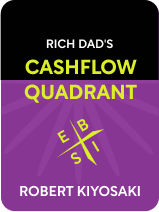

This article is an excerpt from the Shortform book guide to "Rich Dad's Cashflow Quadrant" by Robert T. Kiyosaki. Shortform has the world's best summaries and analyses of books you should be reading.
Like this article? Sign up for a free trial here .
Do you like the idea of living off passive income? What are some forms of passive income you can generate?
According to financial educator Robert Kiyosaki, earning passive income is the key to wealth and is essential for attaining financial freedom. Examples of passive income include dividends from stocks, interest on bonds, and rental income.
Here is why investing is the best way to generate passive income.
How to Live off Passive Income
According to Robert Kiyosaki, the type of income you generate is more important than the type of work you do. Kiyosaki identifies four categories of income, which he calls “cashflow quadrants.” They are:
- Employees (E)
- The self-employed and small business owners (S)
- Big business owners (B)
- Investors (I)
According to Kiyosaki, the best way to generate passive income is through investing. However, he admits that most of us can’t go straight to the I category, because we don’t have enough money to invest yet, or the free time to spend on our investment strategy. Kiyosaki sees the B category as a bridge to the I category: You can generate money to invest and gain some free time in the B category.
The kind of wealth that provides financial freedom is almost always generated in the I quadrant, where it generates passive income. To attain financial freedom, you will nearly always need to have I quadrant income, because that is how you develop the passive income that will make up your livelihood once you stop working.
(Shortform note: You only need to generate B category-level capital in order to invest if you’re aiming to be a capitalist. While Kiyosaki devotes a lot of space to advocating readers set their sight on that kind of wealth, you don’t need to own a B-category business to invest at a smaller scale, even if you’re aiming to “cross over” to living on passive income.)
| Financial Freedom vs. Financial Independence In contrast to Kiyosaki’s focus on financial freedom, Sethi, and most of the personal finance community, stress the importance of “financial independence.” This is the point at which your passive income can pay for all your expenses and you no longer have to work. Financial independence offers more freedom, as Kiyosaki defines it, than financial security, because you no longer need to work. When Kiyosaki talks about financial freedom, he’s usually talking about capitalist-level wealth. In contrast, financial independence can mean 1% level wealth, but since it only means that your passive income is greater than your expenses, you can be financially independent with much less wealth. Some of this difference between “financial freedom” and “financial independence” is semantic, but it’s useful to know what these terms are most likely referring to when you hear them. |
Kiyosaki identifies three ways to use the I category for building streams of passive income:
- Retirement investing. Kiyosaki doesn’t actually include people who invest only for retirement in the I category, because their investments won’t replace their income. However, because of the decline in defined-benefit retirement plans, most people invest for retirement.
- Supplemental investing. Remember, you can exist in multiple categories at the same time. You can be an E, S, or B and supplement that income with passive income earnings from investments.
- Crossover investing. Your goal is to “cross over” to a lifestyle where you live entirely on the passive income you earn from investments. If you cross over, you front-load your work. After you research and make your investment, all you have to do is monitor your passive income to make sure it’s performing well.
| Practicing Crossover Investing Through Retirement and Supplemental Investing Kiyosaki categorizes retirement investing, supplemental investing, and crossover investing as three separate investing types, but both retirement investing and supplemental investing can turn into crossover investing: Many new investors start with retirement investing primarily because it’s easy and accessible—many employers will take contributions directly from your paycheck, before you can spend it. If you consistently invest between 25% and 50% of your paycheck, in 20 years, you may find that you’ve “crossed over” and no longer need to work. Instead, you can live off the income from your investments. At that point, you can use the little-known Rule 72(t) to withdraw funds from your retirement account and avoid the typical 10% penalty for withdrawing funds before age 59½. Supplemental investing also has the potential to get you to the “crossover point.” The bottom line is, the more of your E and S income you save and invest, the likelier you are to achieve crossover investing. |

———End of Preview———
Like what you just read? Read the rest of the world's best book summary and analysis of Robert T. Kiyosaki's "Rich Dad's Cashflow Quadrant" at Shortform .
Here's what you'll find in our full Rich Dad's Cashflow Quadrant summary :
- Why the traditional path of college to career doesn't work
- Which types of income will lead you to financial freedom
- An in-depth look at Robert Kiyosaki's four cashflow quadrants






